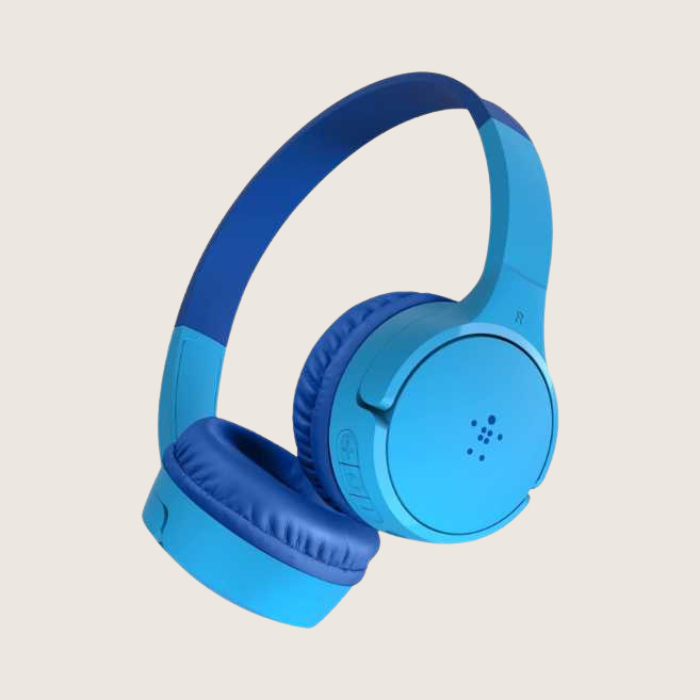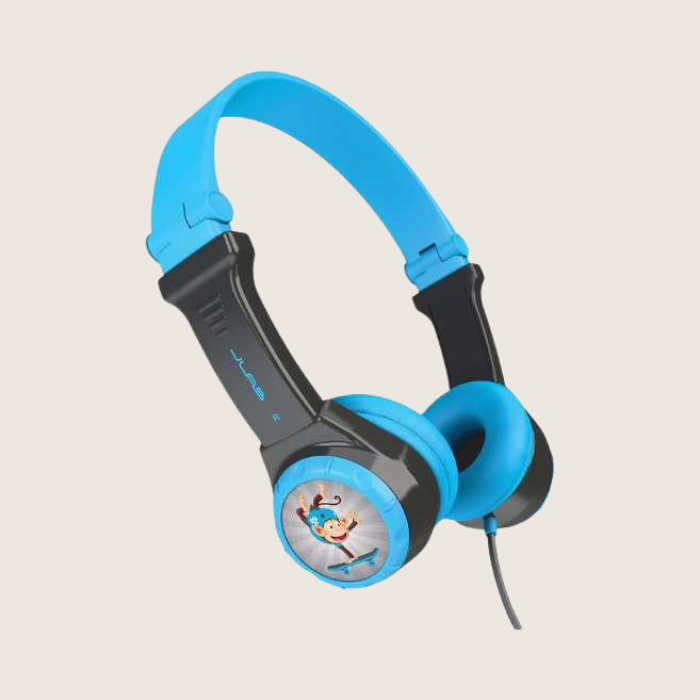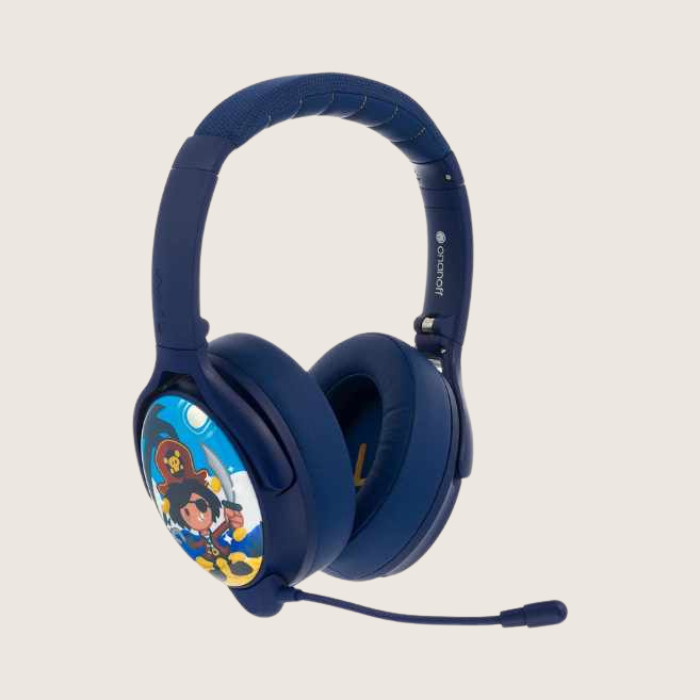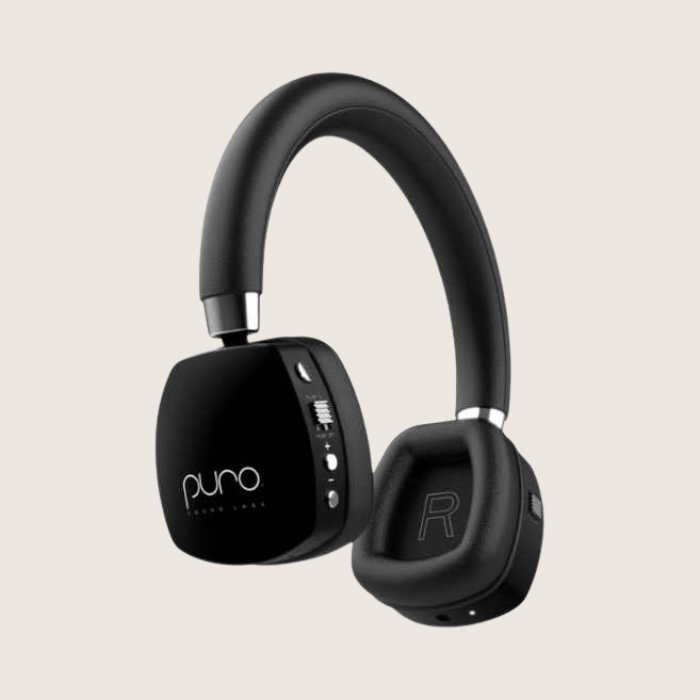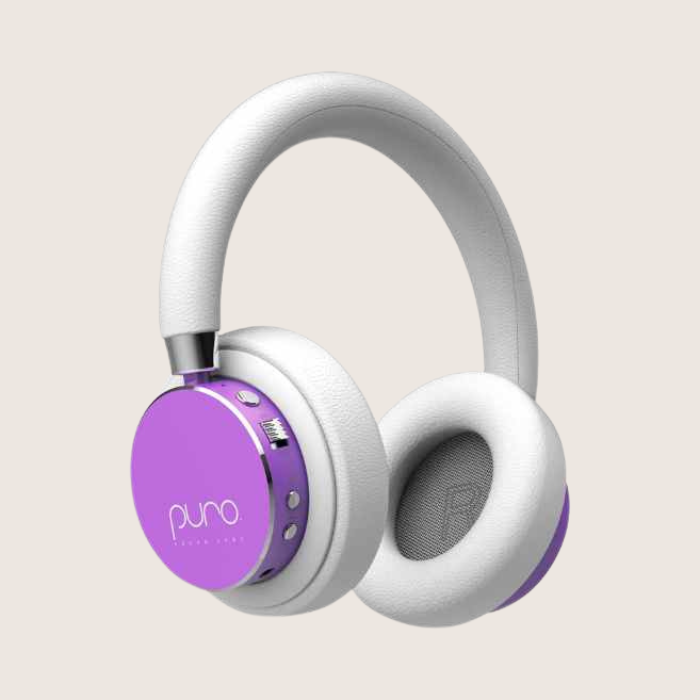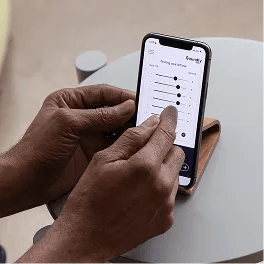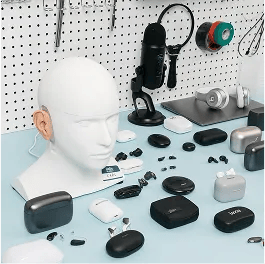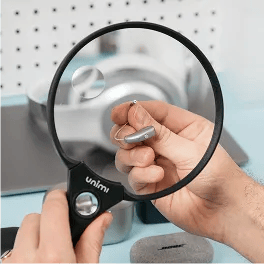- Overview
- Top-Ranked Products
- Why is it important to invest in kid-centric headphones?
- Can kid-centric headphones support a child’s hearing health?
- How to shop for kid-friendly headphones
- Are there certain styles parents should keep in mind?
- A note on volume and safe listening levels from Dr. Amy
- Final Thoughts
- FAQs
Headphones aren’t just for adults juggling Zoom calls and workouts - kids need reliable, safe options too.
Whether it’s for school, travel, or quiet time at home, the right pair can make a big difference in comfort and hearing health.
We spoke with parents and our Audiology Lead Dr. Amy Sarow to find the best headphones for children of all ages. Below, you’ll find our top picks - plus expert-backed advice on what to look for when shopping.
Want to learn more? Consider our guide on hearing aids for kids, too.
- The best options include volume-limiting features to keep sound at safe levels for kids’ hearing.
- Fit and comfort are essential—look for smaller ear cups, soft padding, and adjustable headbands made for younger users.
- Wireless and noise-canceling designs help minimize distractions and make travel or classroom use easier.
- Many picks come with kid-friendly extras, like swappable ear pads or custom stickers.
- 50+ hearing aid brands reviewed and rated by our team of hearing aid wearers and audiologists
- 200+ hours each month spent researching brands and care options
- 2,000,000 people shopped on Soundly in 2024
- 100% independently owned and operated
Read more about our company, services and process here.
Featured in this article
👇 Here are our top picks for safe, comfortable headphones kids can use at school, on the go, or during screen time at home.
Each option balances ease of use, hearing safety, and kid-friendly features. We’ve also included key pros and expert insights to help you choose the best fit.
Belkin SoundForm Mini
- Hearing Protection: 85dB volume limiter ensures safe listening for young ears.
- Versatile Connectivity: Bluetooth 5.0 and an optional wired connection offer compatibility with various devices.
- Durable Design: Spill-resistant materials and a robust build withstand daily wear and tear.
- All-Day Comfort: Adjustable headband and cushioned ear cups provide a secure, comfortable fit.
The Belkin SoundForm Mini provides a kid-focused solution for safe and reliable listening, balancing comfort, durability, and functionality. Designed specifically for children, it addresses common concerns like hearing protection and ease of use.
- The 85dB volume limiter safeguards young ears, while Bluetooth 5.0 connectivity and a built-in microphone make it suitable for school, remote learning, or casual calls.
- Durable, spill-resistant materials and customizable stickers ensure long-lasting use and creativity, while the optional wired connection offers flexibility for various devices.
Its thoughtful design, safety features, and kid-friendly durability make it a practical choice for parents looking for reliable headphones for their child.
- Easy Setup Across Devices
Users appreciate the straightforward Bluetooth pairing, making it simple to connect with devices like tablets, smartphones, and laptops. - Kid-Friendly Comfort
The adjustable headband and padded ear cups provide a snug fit for children, though a few reviewers suggest the headband could be softer for extended use. - Durable and Spill-Resistant
Parents highlight the robust construction, designed to handle daily wear and accidental spills, adding peace of mind for busy households. - Impressive Battery Life
The long-lasting battery is a standout feature, offering up to 30 hours of use—perfect for long trips or busy school days. - Safe Listening Volume
The 85dB volume cap is a key feature for protecting young ears, praised by parents as a thoughtful safety measure. - Minor Drawbacks
While most users are satisfied, a few note that the headphones might feel a bit tight for older kids or prolonged wear.
Overall, reviewers find these headphones practical and reliable, especially for younger users.
- Long battery life (up to 30 hours) for uninterrupted listening.
- Spill-resistant and durability-tested for everyday mishaps.
- Adjustable design fits a wide age range comfortably.
- Built-in microphone for video calls and school activities.
- Includes optional wired connection for added flexibility.
- Headband padding could be softer for prolonged use.
- Tight fit may not suit older kids or larger heads.
- Micro-USB charging port feels outdated compared to USB-C.
JLAB JBuddies Folding Headphones
- Safe Volume Control: Keeps sound capped at 85 dB to protect young listeners’ ears.
- Comfortable Fit: Features padded ear cups and adjustable headband for all-day comfort.
- Durable Design: Tangle-free, braided cord and foldable structure make it travel-friendly.
- Fun Personalization: Comes with stickers and color options, allowing kids to customize their look.
The JLAB JBuddies Folding Headphones offer a child-friendly design with safety-focused features. These headphones are made to fit securely on younger listeners while keeping volume levels at a safe maximum.
- Volume Protection for Young Ears: Equipped with a built-in volume limiter, these headphones cap the sound at 85 dB, a level that helps protect children’s hearing while still delivering clear audio.
- Comfortable, Kid-Sized Fit: With plush, padded ear cups and an adjustable headband, the JBuddies are comfortable for children from 6 to 16, providing a secure, all-day fit.
Compact and foldable, the JBuddies Folding Headphones make a reliable choice for travel or everyday use, with features focused on young listeners’ safety and comfort.
- Great Fit for Kids: Parents appreciate how well these headphones stay on smaller heads, making them a reliable option for travel and everyday listening.
- Volume Limiting for Safety: The volume cap is popular among caregivers who want to protect young ears without sacrificing sound clarity.
- Fun, Kid-Friendly Style: Available in bright colors with stickers for personalization, these headphones are a hit for kids who enjoy customizing their gear.
- Ideal for Tablets and More: The headphones connect seamlessly to devices with a sturdy, tangle-free cord, giving kids hassle-free access to music or shows.
- Minor Fit Issues for Young Toddlers: A few users noted these headphones might be slightly big for toddlers, but they work well for ages 6 and up.
Overall, the JLAB JBuddies headphones offer a balanced mix of safety, comfort, and durability for young listeners.
- Safe listening with a volume cap of 85 dB, ideal for young ears.
- Comfortable, adjustable fit suitable for kids ages 6-16.
- Foldable design and durable braided cord for easy travel use.
- Comes with stickers for added fun and personalization.
- May be too large for very young toddlers under age 6.
- Limited color options may not appeal to all kids’ preferences.
- Ear cups could be snug for older children or teens seeking more room.
BuddyPhones Cosmos+
- Three-tier volume limiting system (75dB, 85dB, 94dB) allows parents to adjust sound protection based on environment and age
- Active noise cancellation and StudyMode enhance focus during online learning and travel
- Dual microphone system includes detachable boom mic for gaming and built-in mic for calls
- Cushioned ear cups and adjustable headband provide comfort during extended wear
The BuddyPhones Cosmos+ combines safety features and versatile functionality in a full-sized headphone design suitable for older children and pre-teens.
- The adjustable volume limiting system offers three distinct safety settings (75dB, 85dB, and 94dB), allowing parents to adapt sound levels based on their child's age and environment while maintaining audio clarity.
- Its dual-mode microphone system enhances communication flexibility - users can switch between the detachable boom mic for gaming and online classes, and StudyMode for improved voice clarity during remote learning.
Overall, the BuddyPhones Cosmos+ provides a practical balance of hearing protection and communication features, making it particularly suitable for students who alternate between in-person and online learning environments.
- Comfort & Fit: Parents consistently report that the headphones are comfortable for extended wear, though some note they may be too large for children under 8.
- Sound Quality & Protection: Users praise the balanced audio output and effective noise cancellation, with particular appreciation for the three-tier volume limiting system.
- School & Learning: Multiple reviewers highlight the StudyMode feature's effectiveness during online classes, noting improved voice clarity and student engagement.
- Travel Performance: Frequent positive mentions of the noise cancellation during flights, with parents appreciating the 94dB travel mode for noisy environments.
- Durability & Build: Most users report robust construction that withstands daily student use, though some mention the boom microphone connection could be more secure.
- Controls & Operation: While adults find the controls straightforward, younger users occasionally struggle with the multifunction button placement and operation.
Overall, users consistently emphasize the headphones' value for school-age children, particularly highlighting their versatility between classroom and travel use.
- Customizable volume limits for different ages and situations
- Effective noise cancellation for travel and study environments
- Enhanced voice clarity through StudyMode feature
- Versatile microphone options for various activities
- Multiple functions might be complex for younger users
- Higher price point compared to basic children's headphones
- May be too large for younger children
Puro Sound Labs Puro Quiet Plus
- Noise Cancellation: Reduces ambient noise by up to 22 dB, ensuring clear listening without increasing unsafe volumes.
- Hearing Safety: Limits volume to a maximum of 85 dB, following recommended safe listening guidelines for kids.
- Wireless Convenience: Bluetooth connectivity with a 30-foot range eliminates cable hassles, allowing free movement.
- All-Day Battery: Up to 35 hours of non-ANC playtime, perfect for long trips or daily use.
The Puro Sound Labs Puro Quiet Plus headphones balance hearing safety with practical use for young listeners.
- The active noise-canceling feature makes environments up to 22 dB quieter, allowing kids to hear clearly without turning up the volume to unsafe levels.
- The Bluetooth connectivity and 35-hour battery life provide seamless, hassle-free listening that’s perfect for long car rides or busy days.
Overall, the PuroQuiet Plus headphones offers a thoughtful mix of safety, comfort, and kid-friendly features, making it a solid choice for young listeners who need volume control and clear sound.
- Comfortable Fit for Kids: Lightweight and adjustable, these headphones fit well on smaller heads, offering comfort for long-term use.
- Effective Noise-Canceling: Users appreciate the active noise cancellation, which helps reduce background noise in busy environments, aiding focus without increasing volume.
- Safe Listening Levels: The volume is capped at 85 dB, which reassures parents concerned about their child’s hearing health during extended use.
- Easy Connectivity: Bluetooth pairing is described as simple and efficient, with a good range that allows kids to move freely while staying connected.
- Impressive Battery Life: Parents find the battery life to be sufficient for a full day’s use, even with ANC enabled.
- Some Noise Still Gets Through: A few users mentioned that while noise isolation is effective, it may not fully block loud noises such as airplane engines.
- Volume limitation for hearing protection at 85 dB.
- Lightweight, comfortable fit designed for kids.
- Long battery life with up to 35 hours of playtime.
- Bluetooth pairing is simple and convenient.
- Built-in microphone, ideal for online learning.
- Noise-canceling may not fully eliminate all external sounds.
- On-ear design might not fit all children comfortably.
- Wired connection is needed once the battery runs out.
Puro Sound Labs BT2200s
- Safe Listening Volume: Volume is capped at 85 dB to protect young listeners’ hearing.
- Clear Sound Quality: Puro Balanced Response Curve delivers full-range audio for an immersive experience.
- Noise Isolation: Blocks up to 83% of ambient noise, reducing the need for higher volumes.
- Comfortable Fit Options: Includes interchangeable ear cups to adjust for comfort and better sound seal.
The Puro Sound Labs BT2200s headphones are designed to provide safe, comfortable listening for young listeners without compromising sound quality.
- With a built-in volume limit of 85 dB, these headphones adhere to WHO guidelines for safe listening, helping to protect young ears from potential damage.
- Passive noise isolation blocks up to 83% of background noise, allowing for clear, immersive audio at lower, safer volumes – ideal for listening in busy environments.
Overall, the BT2200s offer a blend of durability, comfort, and safety features, making them a reliable choice for parents prioritizing both audio quality and hearing protection.
- Safe Listening Volume: Parents appreciate the 85 dB limit, which helps protect young ears from high sound levels and offers peace of mind.
- Clear Sound & Effective Noise Isolation: Users highlight the balanced audio quality and the noise isolation feature, which helps reduce background noise for clear listening in busy settings.
- Comfortable Fit for Different Ages: With interchangeable ear cups, these headphones provide a comfortable fit for various ages, making them suitable for extended wear, even on flights.
- Easy Bluetooth Connectivity: Many users report simple, reliable Bluetooth pairing, allowing kids to connect independently and enjoy hassle-free listening.
- Kid-Friendly Design & Durability: The lightweight, durable design withstands daily activities, offering both comfort and resilience for everyday use.
In summary, the BT2200s provide a well-rounded option for safe, clear, and comfortable listening for kids.
- Built-in volume limiter keeps sound levels safe for young ears.
- Effective passive noise isolation allows for lower, safer listening volumes.
- Durable, lightweight design suitable for kids’ daily wear and travel.
- Vegan leather ear cushions and headband for added comfort.
- Ear cushions may wear over time with frequent use.
- Passive noise isolation only, lacking active noise cancellation.
- Volume limit might be restrictive for older children who prefer louder settings.
Why is it important to invest in kid-centric headphones?
It may be mighty tempting to give your child a pair of headphones you’re not using, but it’s safer—and healthier—to invest in headphones that are kid-sized.
And, there is a difference between headphones for adults and children. “Kids headphones are often made to be more durable, and they frequently come in more kid-friendly color options and styles,” says Dr. Amy Sarow.
She also notes that headphones for children are also manufactured for smaller ears (which helps with comfort and long-term wear for school or extracurriculars).
⭐ But, it’s really about volume controls.
One of the biggest reasons to invest? Volume. Dr. Amy explains: “Some headphones have volume caps built into their system.
What this means is that even at maximum volume, headphones will never exceed a set volume cap,” she says. “For parents, this means one less thing to worry about when it comes to safe listening levels.”
That also means that kid-friendly headphones have a feature called volume caps. Think of them as a handy safety device, already built-in to the headphones or earbuds:
“Volume caps are like guardrails,” Dr. Amy says. “They keep the user automatically within a safe range, so even if attention is elsewhere, the volume won't creep up to dangerous levels.”
Are volume caps a really big deal? Yes. Dr. Amy says that standard headphones can reach volumes up to 110 dB SPL or more (which is quite a lot!), as the recommended listening level for adults is 80 dB.
So, that means that damage to the inner ear can occur within minutes. “Volume caps can prevent possible permanent inner ear damage that can result in hearing loss and tinnitus,” she says.
⭐ Fit is another reason to invest, too.
That’s not all. According to Dr. Amy, the fit means that not only will they fit more securely and be less likely to fall out, but a better fit can also make a difference when it comes to safe volume levels.
“Think of it this way: the speaker output (and size) impacts the volume in the space. The same amount of volume in a smaller space (i.e., smaller ears) means more volume,” she says.
“Additionally, noise cancellation will be most effective with properly fitting headphones, and kids headphones may also include volume-limiting safety features.”
Early childhood educator and parent, Tara Keeley, MSEd in Childhood Education and Childhood Special Education, also has a few pointers for other parents and caregivers out there.
“As my children grow, I realize some things that I bought without much research or thought aren’t a great fit for us,” she says.
“Plus as I get to know them better over time, and they get to know themselves better, I have more ‘look-fors’ than I might have when they were younger.”
Which means, Tara takes into account how her kids process and react to sound—and how that affects her six year old’s stimulation (or response to audio).
Beyond comfort and fit, there’s a big element at play for parents like Tara. In fact, sensory experiences are huge for Tara’s six year old and it’s one of the factors that made her specifically seek out kids headphones.
“He startles with noises that are too loud, too sudden, or just hit his ear in a way he dislikes, so volume that’s easy to adjust and doesn’t go to an outrageous level would be perfect. I’d also like something noise-canceling to minimize distractions,” she says.
(🌟Remember, adults and children should only engage with audio at a limited volume to 70% of maximum or below 80dB.)
Can kid-centric headphones support a child’s hearing health?
Yes, they can. Certainly listening to music or streaming audio in headphones made for kids is good for overall hearing health because almost all of these devices have dB limits.
Some other pluses besides volume controls? A supportive size can provide comfort and decrease fatigue or ear pain from wear. This is important for all children, but it’s majorly essential for kids who experience sensory issues.
How to shop for kid-friendly headphones
Okay so, you’re ready to check out the market offerings and find the best pair for your kid. But, there’s a few things you should keep in mind before you begin.
First off, it’s likely that you’ll invest in more than one pair of headphones as your child grows until about age 10. “Children’s ear canals continue to grow and change until about age 10, at which point they typically reach their adult size,” Dr. Amy says. “Obviously, the outer ear—or, the pinna—and head size continue to grow, but the ear canal volume is key for headphone volume output and headphone safety.” Also, Dr. Amy notes that children younger than age 10 should wear kids headphones for a better fit as well as the appropriate headphone volume for their smaller ear canals.
Now, which brings us to headphone volume. Most kid headphones on the market have features and specs that kids—and adults—both need, most notably volume controls. Dr. Amy says these are the key features to look for in kid-friendly headsets:
- Built-in volume-limiting functionality: Volume limiting ensures that even at maximum volume, your child’s headphones keep levels within reasonable limits.
- Noise cancellation: Noise cancellation is another great feature that also makes it easier for children to listen at safe levels, without the urge to turn volume up over the background noise.
- A lightweight, comfortable fit: Headphones that fit properly around the ear, especially for younger children, ensure better passive noise attenuation than if the headphones are too big and allow noise to come through. Finally, lightweight material ensures that your child will be comfortable wearing their headphones.
Are there other things parents should keep in mind? Absolutely, and Tara shares what she considers when shopping for headphones for her two children under seven years old. “Over-the-ear headphones only. I find earbuds so uncomfortable myself, plus they tend to pop out of tiny ears.”
To add to this, Tara looks for headphones that need to feel good on their heads and ears. “Flexible or adjustable so they’re not too tight or so loose that they’re falling off,” she says. “Cushy padding around the ears.”
Tara’s shopping considerations for parents:
- Comfort: “They need to be comfortable, so a flexible band and appropriate padding are important,” she says. “Plus the padding needs to stay put- we use fairly inexpensive headphones in my classroom, and the flimsy foam pieces are becoming misshapen, ripping, and falling off a few months into the school year.”
- Wireless: “Wireless is ideal, but I don’t want to be charging yet another thing constantly, so long battery life is a must.”
- Kid-friendly designs and colors: “Aside from my kids liking bright colors or cute patterns, distinctive designs make them easier to find in the bottom of a backpack or a pile of kid stuff.”
- Crisp, clear sound: “My 6-year-old is very sensory sensitive, so we need something with a very crisp, clear sound and adjustable volume.”
Are there certain styles parents should keep in mind?
Volume-limiting functionality is super important, but in terms of design parents should prioritize a lightweight design. “Headphones with a lightweight design ensure comfort,” Dr. Amy says. “For children with sensory overstimulation, the material on the ear pad can also be key.”
And, as Tara discussed earlier: Wireless, comfy styles in kid-approved colors and patterns are a major win-win. Don’t put comfort last on the list when it comes to smaller ears. “They absolutely must be comfortable or “cozy,” as my 6-year-old would say,” she says. “There’s no way my kids keep something on their head that’s even a little uncomfortable.”
According to Dr. Amy, if you want comfort-led headphones, it’s important to look for a softer fabric with quality foam to help with comfort. And, don’t forget about ear cups. “Additionally, ear cups that swivel can be more comfortable for longer wear versus ear cups that remain fixed,” she says. “Large, easy-to-use buttons are more child-friendly and another great feature to look for, especially for younger kids.”
A note on volume and safe listening levels from Dr. Amy
💫 “While headphone volume limiting is a great feature, it’s also important to talk to kids about safe listening levels. We’re seeing a lot of noise-induced hearing loss (NIHL) in the younger generations today, and if we’re going to reduce NIHL, we all need to learn how to self-regulate when it comes to our listening habits. When kids get used to thinking about headphone volume, it’s more likely they’ll think about it when it comes to wearing those adult-sized headphones some day.” - Dr. Amy Sarow
Final Thoughts
Protecting your child’s hearing health—and comfort—is critical. If you’re a parent or caregiver, you’ve probably given considerable thought to finding the right pair of kids headphones.
While there’s so many offerings on the market plus personal style and must-have functions can make shopping for a headset an inherently personal and unique experience, there’s quite a few options on the market that work well from school and home to restaurants and travel.
Looking for the right pair of headphones is a process as your child grows and as their needs change, too.
Whether it’s hopping on flights for a family trip or using headphones in the classroom, you might be switching up your research or modifying a short-list of must-have features.
And don’t be dismayed if that list evolves over time, quite often. It’s not unusual.
Tara adds: “As they grow I realize some things that I bought without much research or thought aren’t a great fit for us.
Plus as I get to know them better over time, and they get to know themselves better, I have more ‘look-fors’ than I might have when they were younger.”
Frequently asked questions
It depends on your child’s age and how they’ll use the headphones. Wired models are often more affordable and don’t require charging - ideal for younger kids or classroom use. But for older kids, wireless headphones offer more freedom of movement and fewer tangles. Just be sure to check for a long battery life and reliable volume-limiting features if you go the Bluetooth route.
Most 10-year-olds are at the upper end of the age range for kids headphones. Depending on their ear and head size, they may still benefit from a smaller fit and built-in volume controls. If they’re transitioning to adult-sized headphones, choose a model with adjustable volume settings and a comfortable design to maintain safe listening habits.
Bluetooth headphones can be a good option for kids, especially for travel or school where cords can get in the way. Many models offer kid-safe features like volume caps and long battery life. Just make sure the Bluetooth connection is stable and that the headphones automatically limit sound to 85 dB or less.
Yes - when designed for children, noise-canceling headphones can help them listen at lower, safer volumes by reducing background noise. This is especially useful in busy or loud environments like airplanes or classrooms. For more on the safety of noise cancellation, see our guide to whether noise-canceling headphones are harmful.



